Bicycle Helmets
The Different Types of Bicycle Helmets
Bicycle helmets come in various styles, each designed for specific riding disciplines. Some common types include road helmets for speed enthusiasts, mountain bike helmets for trail riders, and commuter helmets for urban cyclists. Choose a helmet that aligns with your riding style and needs.
- Electric Bike Helmets
- Road Bike Helmets
- BMX Bike Helmets
- Cruiser Bike Helmets
- Winter Bike Helmets
- MTB Bike Helmets
- Urban Commuter Bike Helmets
- Triathlon/Aero Helmet
- Downhill Bike Helmets
- Time Trial Bike Helmets
- Recreational Bike Helmets
- Multi-Sports Bike Helmets
- Convertible Bike Helmets
- XC Bike Helmets
- Kids Bike Helmets
Electric Bike Helmets
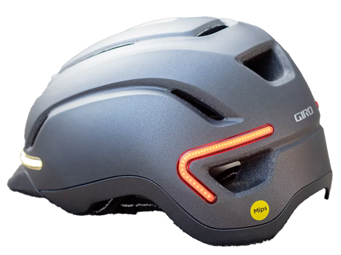 E-bike helmets are specialized gear designed to cater to the unique needs of electric bike riders. With the rising popularity of e-bikes, these helmets offer specific features to ensure safety and comfort for users of motorized bicycles.
E-bike helmets are specialized gear designed to cater to the unique needs of electric bike riders. With the rising popularity of e-bikes, these helmets offer specific features to ensure safety and comfort for users of motorized bicycles.
E-bike helmets often include enhanced impact protection, with technologies like MIPS (Multi-directional Impact Protection System) to reduce rotational forces during crashes.
Many e-bike helmets come equipped with integrated lights, adding visibility and safety during low-light conditions or night riding, a valuable feature for electric bike riders who may travel at higher speeds.
The helmets may also feature rear-view mirrors, allowing riders to monitor traffic and surroundings more effectively, particularly beneficial in urban commuting scenarios.
To accommodate the needs of e-bike users, these helmets often have a streamlined and aerodynamic design, minimizing air resistance and enhancing performance during electric-assisted rides.
The outer shell of e-bike helmets is typically made from durable materials such as polycarbonate or ABS plastic, providing protection against impacts and abrasions.
Inside, expanded polystyrene (EPS) foam absorbs impact energy and cushions the head in the event of accidents or falls.
E-bike helmets may come with adjustable fit systems, ensuring a secure and personalized fit for a comfortable ride.
Safety certifications, such as CPSC or EN 1078, verify that e-bike helmets meet the necessary safety standards for maximum head protection.
Riding an electric bike can be exhilarating, and investing in a high-quality e-bike helmet is a crucial step towards ensuring a safe and enjoyable experience on your electric two-wheeler.
Road Bike Helmets
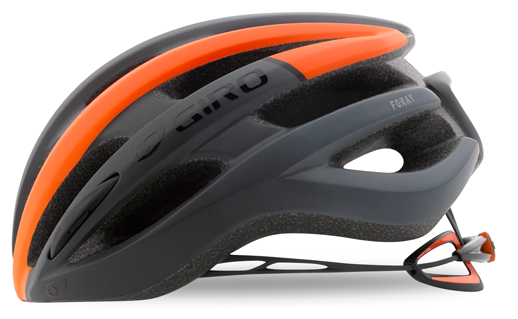 Road bike helmets are essential gear for cyclists who primarily ride on paved roads and prioritize speed and aerodynamics.
Road bike helmets are essential gear for cyclists who primarily ride on paved roads and prioritize speed and aerodynamics.
These helmets are specifically designed to provide maximum protection while maintaining a lightweight and streamlined profile.
Constructed with a hard outer shell typically made of polycarbonate or ABS plastic, road bike helmets feature an inner liner made of expanded polystyrene (EPS) foam, designed to absorb impact forces during a crash or fall.
One of the distinguishing characteristics of road bike helmets is their elongated shape and ample ventilation, allowing for better airflow and cooling during high-intensity rides.
The large vents not only enhance comfort but also prevent overheating, making them ideal for long-distance and intense cycling sessions.
Some models may also incorporate aerodynamic features, reducing wind resistance and increasing performance.
Road bike helmets often come with adjustable fit systems, such as dial or ratchet mechanisms, allowing riders to fine-tune the helmet’s snugness and stability for a personalized and secure fit.
Many helmets in this category also include removable and washable padding, ensuring hygiene and long-lasting comfort.
Safety is paramount, and reputable road bike helmets adhere to industry standards like CPSC (USA), EN 1078 (Europe), or AS/NZS 2063 (Australia/New Zealand), ensuring they provide adequate protection for cyclists.
BMX Bike Helmets
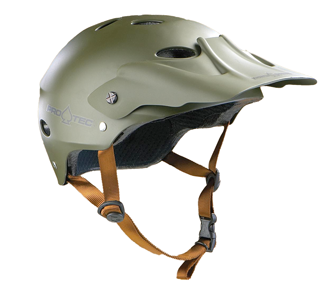 BMX bike helmets are specially designed to cater to the unique needs of BMX riders, providing them with optimal head protection during the high-energy, gravity-defying maneuvers typical of BMX biking.
BMX bike helmets are specially designed to cater to the unique needs of BMX riders, providing them with optimal head protection during the high-energy, gravity-defying maneuvers typical of BMX biking.
These helmets stand out with their distinctive shape, offering more coverage and protection for the back of the head and sides compared to other helmet types.
BMX helmets usually feature a hard outer shell made of durable polycarbonate or ABS plastic, shielding against impacts and abrasions.
The inner liner is typically constructed from expanded polystyrene (EPS) foam, designed to absorb and dissipate impact energy effectively.
What sets BMX helmets apart is their robust build and added reinforcements, ensuring they can withstand multiple impacts and heavy falls.
Many models include additional padding inside for a comfortable and secure fit.
Visors are often incorporated into BMX helmets, providing extra protection from sun glare and shielding the face from debris encountered during intense off-road riding.
While ventilation may not be as extensive as road bike helmets, BMX helmets still include strategically placed vents to allow adequate airflow, maintaining comfort during rigorous riding sessions.
Safety certifications, such as CPSC, EN 1078, or ASTM F2032, are essential factors to consider when choosing a BMX helmet, guaranteeing they meet strict industry standards.
With a variety of colors, designs, and features available, BMX helmets allow you to express yourself while keeping your safety front and center on the track or in the park.
Cruiser Bicycle Helmets
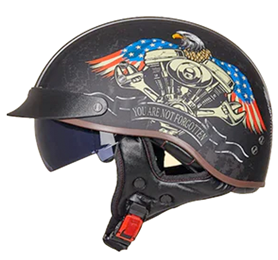 Cruiser bicycle helmets offer a stylish and comfortable head protection solution for cyclists who prefer a relaxed and leisurely riding experience.
Cruiser bicycle helmets offer a stylish and comfortable head protection solution for cyclists who prefer a relaxed and leisurely riding experience.
Ideal for those cruising through city streets, beachside boardwalks, or scenic bike paths, these helmets combine practicality with a retro-inspired design, making them a popular choice among casual riders.
Cruiser helmets typically feature a classic shape with a rounder profile, covering the back of the head for enhanced protection during relaxed rides.
The outer shell is often made from durable materials such as ABS plastic or polycarbonate, ensuring longevity and resistance to minor impacts.
With an inner liner crafted from expanded polystyrene (EPS) foam, cruiser helmets excel at absorbing and dispersing impact energy, ensuring safety without compromising comfort.
Ventilation is a key consideration, as cruiser helmets are designed for slower-paced rides.
They usually incorporate fewer, larger vents that still provide sufficient airflow for pleasant urban cruising or scenic explorations.
Many cruiser helmets prioritize comfort, featuring soft and removable padding that can be washed to maintain freshness and hygiene.
Style plays a significant role in cruiser bicycle helmets, and they are available in a variety of colors and retro designs, allowing cyclists to express their individuality while riding.
When selecting a cruiser helmet, look for those meeting safety standards such as CPSC, EN 1078, or AS/NZS 2063, guaranteeing the helmet provides adequate protection.
Winter Bicycle Helmet
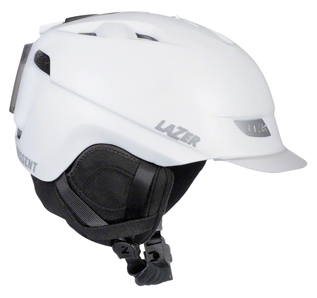 Winter bicycle helmets, also known as cold-weather helmets, are specialized helmets designed to keep cyclists warm and comfortable during colder riding conditions.
Winter bicycle helmets, also known as cold-weather helmets, are specialized helmets designed to keep cyclists warm and comfortable during colder riding conditions.
They are specifically crafted to address the challenges of cycling in cold weather, ensuring that riders can continue their cycling adventures throughout the winter season.
Winter helmets typically feature a unique design with additional insulation or removable ear pads to provide extra warmth and protection for the ears and cheeks, which are vulnerable to cold temperatures and wind.
These helmets often come with adjustable vents or ventilation systems that can be closed to reduce airflow, preventing cold air from reaching the head and keeping the rider insulated and comfortable.
Many winter helmets incorporate soft and insulating liners, such as fleece or thermal materials, to enhance warmth and provide additional comfort in freezing weather.
Some winter helmets may have adjustable fit systems to ensure a secure fit, even when wearing additional layers like balaclavas or beanies.
While warmth is a priority, winter helmets still prioritize safety and adhere to standard safety certifications, such as CPSC or EN 1078, to provide necessary head protection.
Winter bicycle helmets are a valuable accessory for cyclists who refuse to let cold temperatures deter them from enjoying the exhilarating experiences of winter riding.
They provide comfort and protection, enabling cyclists to confidently tackle their winter journeys with ease.
MTB – Mountain Bike Helmet
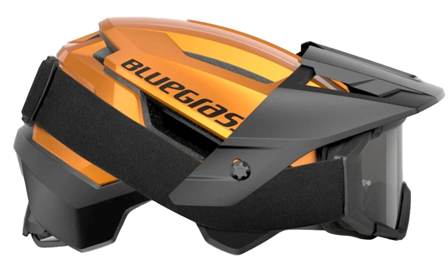 MTB (Mountain Bike) bicycle helmets are an essential piece of protective gear designed specifically for off-road enthusiasts who tackle rugged terrains and challenging trails.
MTB (Mountain Bike) bicycle helmets are an essential piece of protective gear designed specifically for off-road enthusiasts who tackle rugged terrains and challenging trails.
These helmets are engineered to provide superior coverage and durability, ensuring maximum head protection during intense mountain biking adventures.
With a distinct shape, MTB helmets offer extended coverage at the back and sides of the head, safeguarding riders from potential impacts and falls.
The outer shell of MTB bicycle helmets is typically constructed from robust materials such as polycarbonate or ABS plastic, ensuring resilience against the rough and tumble of mountain biking.
To absorb and disperse impact forces effectively, the inner liner is made from expanded polystyrene (EPS) foam, providing excellent shock absorption properties.
MTB helmets are equipped with ample ventilation, featuring numerous vents strategically placed to keep riders cool during strenuous climbs and thrilling descents.
Some MTB helmets incorporate additional features like adjustable visors to shield the eyes from sun glare and protect the face from flying debris.
A secure and personalized fit is crucial, and MTB helmets often come with adjustable fit systems, such as dial or ratchet mechanisms, allowing riders to fine-tune the helmet to their unique head shape and size.
Safety certifications, such as CPSC, EN 1078, or ASTM F1952, ensure MTB helmets meet stringent industry standards, guaranteeing their protective capabilities.
For mountain biking enthusiasts, investing in a high-quality MTB bicycle helmet is a non-negotiable priority, as it provides the confidence and reassurance to conquer challenging trails while staying protected throughout every thrilling ride.
Urban Commuter Bicycle Helmets
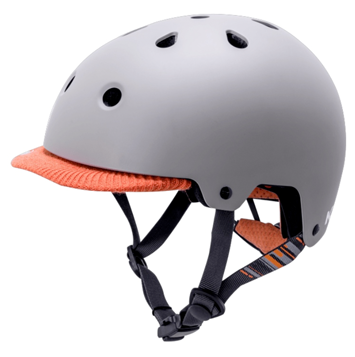 Urban commuter bicycle helmets are designed with the everyday cyclist in mind, offering a perfect blend of style, comfort, and functionality for city dwellers and commuters.
Urban commuter bicycle helmets are designed with the everyday cyclist in mind, offering a perfect blend of style, comfort, and functionality for city dwellers and commuters.
These helmets cater to riders who navigate busy streets, cycle paths, and urban environments, prioritizing safety and convenience during their daily rides.
Urban commuter helmets typically feature a sleek and streamlined design, making them visually appealing while also reducing wind resistance during city riding.
The outer shell is crafted from durable materials like ABS plastic or polycarbonate, providing protection against minor impacts and scratches that can occur during daily use.
With an inner liner made from expanded polystyrene (EPS) foam, these helmets effectively absorb impact energy, ensuring head protection in case of accidents or falls.
Ventilation is essential for comfortable urban commuting, and these helmets are equipped with multiple vents, allowing for adequate airflow to keep riders cool and fresh on busy city streets.
Many urban commuter helmets are designed to accommodate accessories such as integrated lights, reflective elements, or mountable camera mounts, enhancing visibility and practicality for urban riders.
To ensure a secure fit, these helmets often feature adjustable fit systems, allowing riders to customize the helmet’s tightness and stability according to their preference.
Safety certifications, such as CPSC or EN 1078, ensure that urban commuter helmets meet rigorous safety standards, providing peace of mind to riders.
For those navigating the urban jungle on their bikes, investing in a high-quality urban commuter helmet is an essential choice.
Triathlon Helmet / Aero Helmet
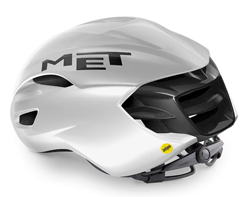 The triathlon helmet, also known as the aero helmet, is a specialized piece of gear designed to enhance performance during triathlon events.
The triathlon helmet, also known as the aero helmet, is a specialized piece of gear designed to enhance performance during triathlon events.
Geared towards speed and aerodynamics, this helmet is engineered to minimize air resistance, reducing drag and allowing triathletes to achieve faster times.
The unique design of the triathlon helmet features a sleek, elongated shape, optimizing airflow and reducing turbulence, especially when in the aerodynamic “aero bars” position on the bike.
The outer shell of the helmet is typically made from lightweight and durable materials such as polycarbonate or carbon fiber, ensuring both protection and minimal weight.
Aero helmets often feature fewer and strategically positioned vents compared to other helmet types, focusing on aerodynamics rather than extensive ventilation.
To further reduce wind resistance and enhance performance, some models may come with an integrated visor, eliminating the need for separate sunglasses during the cycling leg of the triathlon.
The inner lining of the helmet is crafted from expanded polystyrene (EPS) foam, absorbing impact energy and providing necessary head protection in case of falls or accidents.
A secure and precise fit is essential, and many triathlon helmets incorporate adjustable fit systems, allowing athletes to fine-tune the helmet for maximum comfort and stability.
Safety certifications, such as CPSC or EN 1078, ensure that triathlon helmets meet strict safety standards, providing confidence to athletes during high-speed triathlon competitions.
For triathletes seeking to optimize their performance in the cycling leg, investing in a top-quality triathlon helmet can lead to improved speeds and reduced energy expenditure, resulting in a more competitive race.
Downhill Helmets
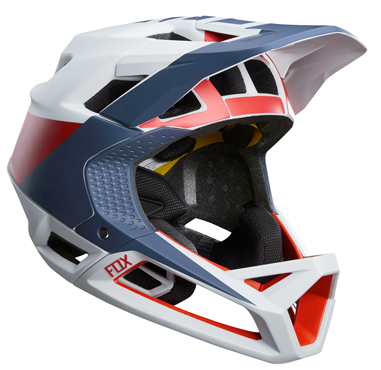 Downhill helmets are purpose-built to provide maximum protection for riders engaging in aggressive downhill mountain biking, bike park riding, and extreme trail adventures.
Downhill helmets are purpose-built to provide maximum protection for riders engaging in aggressive downhill mountain biking, bike park riding, and extreme trail adventures.
The most distinctive feature of downhill helmets is their full-face coverage, encompassing the entire head, including the chin and face, offering unparalleled protection during high-speed descents and technical sections.
These helmets are constructed with reinforced and durable materials, such as fiberglass or carbon fiber, to withstand the impacts and forces experienced during intense downhill riding.
The inner liner of downhill helmets is designed with high-density foam or padding, ensuring optimal shock absorption and impact dispersion.
To shield the eyes and face from the elements, downhill helmets are equipped with a large and adjustable visor, providing protection against sun, rain, and debris.
While ventilation is a secondary concern for downhill riders, these helmets still feature some vents strategically placed to maintain adequate airflow and prevent overheating during challenging descents.
The secure fit of downhill helmets is crucial to prevent movement during aggressive riding. Many models come with adjustable chin straps and padding to ensure a personalized and comfortable fit.
Downhill helmets meet stringent safety certifications such as ASTM F1952 (USA) or EN 1078 (Europe), guaranteeing they adhere to the highest industry safety standards.
The substantial and robust design of downhill helmets may result in slightly more weight compared to other helmet types, but the added protection is well worth it for those engaging in extreme mountain biking.
With their uncompromising focus on safety and durability, downhill helmets instill confidence in riders to push their limits and conquer challenging trails while keeping their head optimally protected.
For riders seeking adrenaline-pumping thrills and high-speed descents, investing in a top-quality downhill helmet is a non-negotiable step towards ensuring a safe and exhilarating downhill biking experience.
Time Trial Helmets
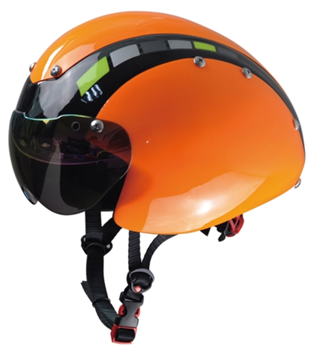 Time trial helmets are specialized gear designed for competitive time trial events in cycling.
Time trial helmets are specialized gear designed for competitive time trial events in cycling.
They feature a unique teardrop-shaped design, meticulously engineered to minimize air resistance and enhance aerodynamics, enabling cyclists to achieve maximum speed during solo races against the clock.
These helmets prioritize speed over ventilation, often incorporating fewer vents to optimize aerodynamic performance during high-intensity efforts.
The elongated and sleek shape of time trial helmets is aimed at reducing drag and turbulence, making them highly effective in shaving off valuable seconds during time trial stages of road races or individual time trial competitions.
Many time trial helmets are designed to provide frontal and top head coverage, ensuring adequate protection without compromising aerodynamics.
Some models may also come with an integrated visor to further reduce turbulence around the rider’s face, offering improved aerodynamic advantages.
Safety is paramount, and time trial helmets meet strict safety standards such as CPSC or EN 1078, ensuring they offer the necessary protection during high-speed racing.
For competitive cyclists seeking to gain a decisive advantage in time trials, investing in a high-quality time trial helmet is a pivotal step toward achieving peak performance and breaking personal records.
Recreational Helmets
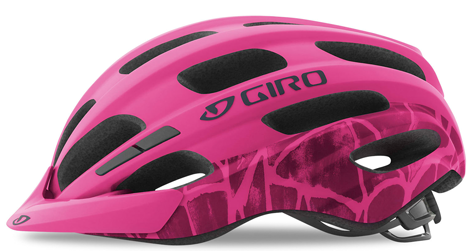 Recreational helmets are designed for casual and leisurely cyclists who enjoy relaxed rides around the neighborhood, on bike paths, or during weekend outings.
Recreational helmets are designed for casual and leisurely cyclists who enjoy relaxed rides around the neighborhood, on bike paths, or during weekend outings.
These helmets prioritize comfort and simplicity, offering basic head protection for everyday riding scenarios.
The design of recreational helmets typically features a traditional half-shell style, providing coverage for the top, back, and sides of the head.
While they may not offer the extended protection of specialized helmets, they still serve as a reliable safeguard for low-risk cycling activities.
Recreational helmets often come with multiple vents strategically placed to promote airflow and keep riders cool during easy-going rides in mild weather conditions.
They are lightweight and easy to wear, making them ideal for riders of all ages and skill levels, including kids and beginners.
Many recreational helmets come with adjustable fit systems, allowing riders to customize the helmet’s tightness for a secure and comfortable fit.
Safety is essential, and recreational helmets adhere to standard safety certifications, such as CPSC or EN 1078, ensuring they meet the necessary industry safety standards.
Available in various colors and designs, recreational helmets offer a wide array of options to match personal preferences and style.
For cyclists who seek a no-fuss and reliable helmet for leisurely rides and family outings, recreational helmets provide the perfect balance of simplicity, comfort, and protection, making them a popular choice for riders seeking a laid-back cycling experience.
Multi Sports Helmets
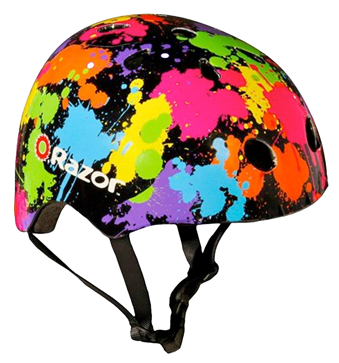 Multi-sport helmets are versatile protective gear designed to cater to the needs of athletes engaged in various sports and outdoor activities.
Multi-sport helmets are versatile protective gear designed to cater to the needs of athletes engaged in various sports and outdoor activities.
These helmets offer the convenience of being suitable for multiple disciplines, providing head protection across a range of activities.
Multi-sport helmets are commonly used in activities like cycling, skateboarding, rollerblading, scootering, and even skiing or snowboarding, making them a practical choice for individuals who enjoy diverse outdoor pursuits.
They typically feature a half-shell design, providing coverage for the top, back, and sides of the head, offering reliable protection during different sporting activities.
Many multi-sport helmets come with adjustable fit systems, allowing users to customize the fit for a secure and comfortable helmet, regardless of the activity.
The inner liners of multi-sport helmets may include moisture-wicking materials, ensuring sweat management and comfort during intense workouts.
Safety certifications, such as CPSC or ASTM F1492, verify that multi-sport helmets meet the necessary safety standards across various sports.
Multi-sport helmets are a cost-effective solution for individuals engaged in multiple activities, eliminating the need to purchase separate helmets for each sport.
With their adaptability and protective features, multi-sport helmets provide athletes and outdoor enthusiasts with a versatile headgear option, keeping them safe and confident in their pursuits, no matter the sport or adventure.
Convertible Helmets
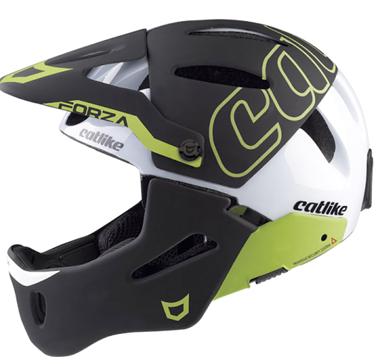 Convertible helmets, also known as 2-in-1 helmets, are innovative gear designed to adapt to varying riding conditions and preferences. They offer the flexibility to transform from a full-face helmet to an open-face or half-shell style, making them suitable for different cycling scenarios.
Convertible helmets, also known as 2-in-1 helmets, are innovative gear designed to adapt to varying riding conditions and preferences. They offer the flexibility to transform from a full-face helmet to an open-face or half-shell style, making them suitable for different cycling scenarios.
The versatility of convertible helmets allows riders to switch between full-face protection for aggressive downhill mountain biking or bike park riding and open-face mode for casual trail riding or climbing.
These helmets typically feature a removable chin guard or face shield that can be attached or detached based on the rider’s needs, providing convenience and adaptability on the go.
Convertible helmets often come with a secure locking mechanism to ensure a sturdy and reliable connection between the full-face and open-face configurations.
They may have adjustable fit systems and ventilation options in both configurations, providing a comfortable and customizable fit for riders during any type of riding.
Convertible helmets meet stringent safety certifications like CPSC or ASTM F1952, ensuring they offer the necessary protection in both full-face and open-face modes.
With the ability to switch between full-face and open-face styles, convertible helmets are an excellent choice for riders who participate in various mountain biking disciplines, providing the perfect blend of protection and ventilation for any trail or terrain.
Investing in a convertible helmet offers the convenience of two helmets in one, granting riders the freedom to tackle diverse riding scenarios with ease and confidence.
XC Bike Helmets
(Sub-category of MTB Helmets)
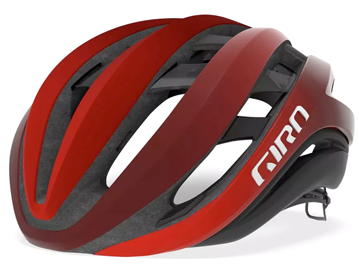 XC (Cross-Country) bicycle helmets are a specific type of helmet designed for cross-country mountain biking.
XC (Cross-Country) bicycle helmets are a specific type of helmet designed for cross-country mountain biking.
While they share some similarities with other types of helmets, they are tailored to cater to the unique needs of cross-country riders and the terrain they encounter.
XC helmets typically have a lightweight and well-ventilated design, prioritizing breathability and comfort during long-distance rides and climbs.
They often feature a half-shell design, providing coverage for the top, back, and sides of the head while maintaining a balance between protection and ventilation.
XC helmets may have more vents compared to other MTB (Mountain Bike) helmets, ensuring excellent airflow to keep riders cool in warm conditions.
These helmets are designed to be versatile and suitable for various off-road terrains encountered during cross-country riding, from smooth trails to technical sections.
While XC helmets may not offer the same level of extended coverage and robustness as downhill helmets or full-face MTB helmets, they still meet industry safety standards and provide adequate protection for the discipline.
XC helmets can be used for other cycling activities, such as recreational riding and trail biking, making them a popular choice for riders seeking a well-rounded helmet.
In summary, XC bicycle helmets are a specific subcategory of MTB helmets, catering to the needs of cross-country riders with their lightweight, well-ventilated design and versatile functionality for off-road terrain.
Kids Bicycle Helmets
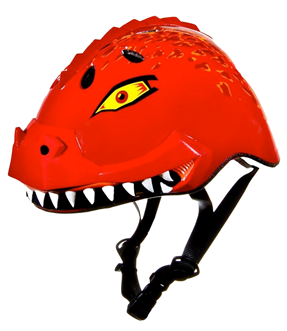 Kids bicycle helmets are essential safety gear designed to protect the heads of young cyclists during their biking adventures. These helmets are specially crafted to meet the needs of children and offer a secure and comfortable fit for their smaller heads.
Kids bicycle helmets are essential safety gear designed to protect the heads of young cyclists during their biking adventures. These helmets are specially crafted to meet the needs of children and offer a secure and comfortable fit for their smaller heads.
The outer shell of kids’ bicycle helmets is typically made from durable materials such as ABS plastic or polycarbonate, providing impact resistance to withstand falls and collisions.
Inside, the helmets feature an inner lining made from expanded polystyrene (EPS) foam, which effectively absorbs impact energy, reducing the risk of head injuries.
Many kids’ helmets come with multiple vents strategically placed to maintain airflow and prevent overheating during active play.
Adjustable fit systems, like dial or strap mechanisms, are common features in kids’ helmets, allowing parents to customize the fit for their child’s head size. This ensures a snug and secure fit, preventing the helmet from moving or slipping during rides.
Kids’ bicycle helmets often feature fun and colorful designs, appealing to children and encouraging them to wear their helmets regularly.
Safety certifications, such as CPSC or ASTM F1492, ensure that kids’ helmets meet stringent safety standards, providing parents with peace of mind.
Instilling the importance of helmet safety at a young age sets a foundation for a lifetime of safe cycling habits.
Investing in a high-quality kids’ bicycle helmet is a crucial step in ensuring the safety of young riders as they explore the world on their bikes.

